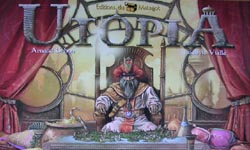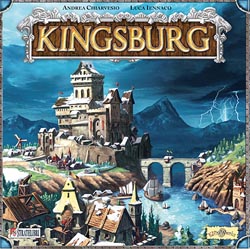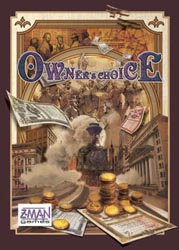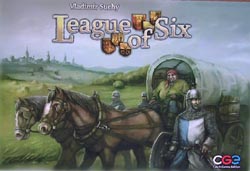 This week we travelled to Utopia to help the Utopian king develop its four islands by inviting princes from the five great civilizations to visit and build monuments and wonders around the many districts of the kingdom. The game was designed by Ludovic Vialla and Arnaud Urbon and published by Matagot / Rio Grande.
This week we travelled to Utopia to help the Utopian king develop its four islands by inviting princes from the five great civilizations to visit and build monuments and wonders around the many districts of the kingdom. The game was designed by Ludovic Vialla and Arnaud Urbon and published by Matagot / Rio Grande.
Utopia is played in rounds until one player has accumulated at least 50 prestige points to trigger the endgame. Each round proceeds the same way. First, Guest tokens are drawn randomly until you have 3 times the number of players. Each Guest token has a picture of a citizen of one of the 5 civilizations as well as a symbol corresponding to one of the 4 islands on the board. In the first phase of a round, the arrival of the Princes, the players will, one at a time, remove one of the Guest tokens from the board and place one of their matching Prince tokens on any of the districts of the appropriate island. If a player is able to group 3 of their prince tokens of the same civilization together in the same district, the tokens may be removed from the board and replaced with a monument of the appropriate kind. Also on their turn, if a player has a Prince from each of 5 civilizations on the same island, one of the 4 wonders can be built on the island. The builder of the wonder immediately receives 6 prestige points and, whenever any other player builds a monument on that island, he receives between 1 and 4 additional prestige points.
In the second phase of a round, development of the city, all players are randomly dealt 5 Action Cards, which are simply cards depicting each of the 5 different civilizations. Then in turn order, the players carry out as many actions using their Action Cards as they so choose. A player may refrain from using all their cards, but may only carry over a maxium of 5 cards. The actions involve adding, removing or moving princes, or altering the popularity of a civilization. The last of these can be important because after all players have taken their turns playing action cards, calculation of prestige occurs. In scoring, the players receive prestige points for each monument they possess based on the civilization’s popularity so each monument can be worth between 1 and 5 points. If a player reaches 50 or more points in this phase, the game ends at the end of the round and the player with the most points wins.
In our game, Steve started off trying to control the Island of Water and for the most part succeeded in persuading others to concentrate elsewhere, at least for a while. Most people tried to establish one or two quick monuments, although the early builders, Mark K and I, found that the monuments of these civilizations magically weren’t terribly popular. Guy was the first to build a wonder and did so on an island where lots of monuments had still to be built. However, he was also able to build some monuments soon after and his position looked very strong. Mark G soon managed to get 1 monument in each of the five civilizations so then was guaranteed to rake in 15 points per round. My challenge faded when I misread one of the monuments on Steve’s Island of Water and so the wonder I was seeking to build there ended up a man short and Steve built the wonder ahead of me on the next turn. It did mean I was able to build a couple more monuments in the final round and scored a massive 24 points in that scoring but I still came up short with Guy maintaining a fairly comfortable lead.
Utopia seemed to be nearly a very good game. It took longer to play than we had expected and it was a bit dry and brain burning. However, it played solidly and the production is top-notch, although distinguishing between different monuments and civilizations should have been made easier.. All of us thought it was a borderline 6/7 but most of us came down on the 6 side. I wonder how playing with fewer players might alter things.

 Having missed out on Friday’s regular session, Chris and I sat down on Sunday afternoon to play Race for the Galaxy. The game takes a bit of explaining but Chris picked up the basic strategies pretty well. However, with this being his first try at the game, he was further down the learning curve as far as determining how the card combinations work well together. We played the advanced two player version with each player picking two actions per turn, as I thought this would get the game moving a lot quicker.
Having missed out on Friday’s regular session, Chris and I sat down on Sunday afternoon to play Race for the Galaxy. The game takes a bit of explaining but Chris picked up the basic strategies pretty well. However, with this being his first try at the game, he was further down the learning curve as far as determining how the card combinations work well together. We played the advanced two player version with each player picking two actions per turn, as I thought this would get the game moving a lot quicker. This week, we had another go at Kingsburg – our January game of the month. Guy had not played before but, as it is a dice game, we explained that Mark G was hot favourite.
This week, we had another go at Kingsburg – our January game of the month. Guy had not played before but, as it is a dice game, we explained that Mark G was hot favourite. Just a note to let people know that the Shrewsbury Boardgames Club are meeting this Friday 21 March 2008 at Garry’s house.
Just a note to let people know that the Shrewsbury Boardgames Club are meeting this Friday 21 March 2008 at Garry’s house. This week, Guy joined us for the first time and we started out by trying Darjeeling, a game based on the tea trade by Gunter Burkhardt and published by Abacus / Rio Grande.
This week, Guy joined us for the first time and we started out by trying Darjeeling, a game based on the tea trade by Gunter Burkhardt and published by Abacus / Rio Grande. Cartagena 2 is designed by Leo Colivini and published by Winning Moves / Rio Grande. The gameplay is very similar to the original Cartagena but has different rules for regaining cards and you now have to ferry your pirates between two islands.
Cartagena 2 is designed by Leo Colivini and published by Winning Moves / Rio Grande. The gameplay is very similar to the original Cartagena but has different rules for regaining cards and you now have to ferry your pirates between two islands. The latest issue of Counter arrived yesterday. Apart from the very (blindingly so) yellow cover, this 84 page edition features reviews of Amyitis, Brass, Chicago Poker, Darjeeling, In the Year of the Dragon, Owner’s Choice and Race for the Galaxy, among others. There is also the traditional top 5 lists of 2007 (or 2005 as the contents page suggests – sack the proof reader), some variants for a number of Ragnar Brothers games, a comparison of El Capitan and its predecessor, Tycoon, an interesting piece on downloadable cardgames (which I need to investigate further), the usual letters column and more.
The latest issue of Counter arrived yesterday. Apart from the very (blindingly so) yellow cover, this 84 page edition features reviews of Amyitis, Brass, Chicago Poker, Darjeeling, In the Year of the Dragon, Owner’s Choice and Race for the Galaxy, among others. There is also the traditional top 5 lists of 2007 (or 2005 as the contents page suggests – sack the proof reader), some variants for a number of Ragnar Brothers games, a comparison of El Capitan and its predecessor, Tycoon, an interesting piece on downloadable cardgames (which I need to investigate further), the usual letters column and more. With a bit of time left, we opted for a quick game of Liar’s Dice. Very quick in Steve’s case as, even though we all started with six dice, he still managed to lose them all in two turns. Mark K also succumbed pretty quickly but did suffer from an unlikely dice combination. Nige, on the other hand, was uncharacteristically managing to hold onto his and got down to the final two in a face off with me. Although he started out by gaining a dice advantage over me, quality eventually came through and I was able to claim the win. Fantastic game, as always.
With a bit of time left, we opted for a quick game of Liar’s Dice. Very quick in Steve’s case as, even though we all started with six dice, he still managed to lose them all in two turns. Mark K also succumbed pretty quickly but did suffer from an unlikely dice combination. Nige, on the other hand, was uncharacteristically managing to hold onto his and got down to the final two in a face off with me. Although he started out by gaining a dice advantage over me, quality eventually came through and I was able to claim the win. Fantastic game, as always. This week, I had just picked up two new Z-Man games and so was keen to give them a try. The first, Owner’s Choice designed by Yasutaka Ikeda, is a stock market game of buying low and selling high with prices driven by a series of dice.
This week, I had just picked up two new Z-Man games and so was keen to give them a try. The first, Owner’s Choice designed by Yasutaka Ikeda, is a stock market game of buying low and selling high with prices driven by a series of dice. Pandemic is designed by Matt Leacock and published by Z-Man Games. It is about the spread of diseases around the globe and the efforts of a disease control team to find a cure and save the world. It is another addition to the small group of interesting co-operative games released in recent years.
Pandemic is designed by Matt Leacock and published by Z-Man Games. It is about the spread of diseases around the globe and the efforts of a disease control team to find a cure and save the world. It is another addition to the small group of interesting co-operative games released in recent years. This week, we played League of Six, designed by Vladimir Suchy and published by Czech Games Edition. The game is about tax collecting in a 15th century European kingdom. Players aim to impress the king by being the most successful tax collector over six years (rounds).
This week, we played League of Six, designed by Vladimir Suchy and published by Czech Games Edition. The game is about tax collecting in a 15th century European kingdom. Players aim to impress the king by being the most successful tax collector over six years (rounds). We finished of with R-Eco, a quick card game by Susumu Kawasaki and published by Z-Man Games. The game is about the virtues of recycling and the evils of dumping waste.
We finished of with R-Eco, a quick card game by Susumu Kawasaki and published by Z-Man Games. The game is about the virtues of recycling and the evils of dumping waste.